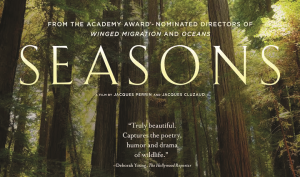 Co-directors and co-writers Jacques Perrin and Jacques Cluzaud have struck gold once again with “Seasons,” a French documentary that takes us deep inside the forest to explore the intrinsic relationship between humans and animals. Combining stunningly intimate shots of nature’s diversity with a compelling soundtrack, “Seasons” leaves its audience with a sense of wonder and enlightenment.
Co-directors and co-writers Jacques Perrin and Jacques Cluzaud have struck gold once again with “Seasons,” a French documentary that takes us deep inside the forest to explore the intrinsic relationship between humans and animals. Combining stunningly intimate shots of nature’s diversity with a compelling soundtrack, “Seasons” leaves its audience with a sense of wonder and enlightenment.
The film begins 80,000 years ago in Europe. The Earth has just tilted toward the sun, bringing an end to the seemingly interminable winter and establishing a cycle of seasons. We are then transported 68,000 years into the future, where it is springtime. New life emerges, and the modern forest is born, quickly enveloping the continent. The remainder of the documentary cycles through the seasons and traverses through time, progressing from the era of hunter-gatherers to the desecration of the forest at the hands of greed and war.
What sets “Seasons” apart from other nature documentaries is its total simplicity. There is no narrator describing the images before the viewer’s eyes. After a brief introductory narration, the soundscape replaced by provoking melodies and the sounds of nature. Even without words, Perrin and Cluzaud manage to tell a compelling story. The film’s music, courtesy of famed composer Bruno Coulais (Coraline, The Crimson Rivers), speaks to the audience’s emotions and perfectly complements the film’s action. Moments of suspense, like chases or stampedes, are matched with booming drums, sharp violins and quick tempos. In contrast, moments of serenity, like snowfalls or rainstorms, are set against light pianos, gentle flutes and elegant harps.
Animal “dialogue” fills any non-musical gap. The documentary intimately acquaints us with various birdsongs, the grunt of a hog, a fox’s purr and the whinny of horses as they feud with one another. The animals replace traditional actors, thus becoming the characters with whom we fall in love.
The film is devoid of humans, allowing the audience to empathize with the animals. We root for the pig running from the hungry wolf. We laugh at the baby deer struggling to walk. We are enchanted by the night owl and amused by the scurrying squirrels. The more time we spend without human intervention, the more we become a part of the natural world. Although the absence of dialogue can be monotonous at times, it forces viewers to challenge the conventional mindset that places humans at the apex of nature.
Perrin and Cluzaud shy away from any sort of political statement with this film. They are not calling for humans to reject their belongings and become one with the wild. Rather, the film aims to show the immense power that man has over nature and how that power has been abused. After the hunter-gatherers left, the forest began to thin out and was replaced by countryside and plains. Humans began to take more and more from the forest to construct their ships, castles and cities. Animals began to be seen more as pests than the natural inhabitants, as indicated by the brutal scenes of hunters tracking down wolves and killing them. The only places for these lovely beasts to take refuge are the mountains, far from their natural home. Eventually, even the beautiful birdsongs are silenced by the sounds of war, extinguishing the final remnants of the forests that we grow to love throughout the film.
However, Perrin and Cluzaud leave the audience not with despair but a message of hope: Nature is not giving up. The film suggests that animals have thoughts and motivations just like humans do. Their message that man modifies nature does not have to be a negative one. It suggests that we can coexist with nature — not work around it. We have the power to further animal life and the growth of forests, plains and valleys.
Perrin and Cluzaud have traveled high and low in order to explore the deepest dimensions of nature, and their findings as portrayed in “Seasons” are nothing short of spectacular. Their documentary offers more than stunning shots and calming music. It leaves the viewer questioning his or her existence in relationship to other living organisms. By the end of film, any conscientious viewer should have a stronger desire to connect with and care for nature, as well as a deeper understanding of the power that humankind has in shaping the seasons.














